Au-Graphene Hybrid Plasmonic Nanostructure Sensor Based on Intensity Shift
Abstract
:1. Introduction
2. Numerical Methodology
3. Results and Discussion
3.1. Contribution of the Hybrid Au-Graphene (Au-G) Nanostructure
3.2. Effects of Au NP Size, Shape, and Structural Periodicity on Extinction
3.3. Sensitivity Measurement
4. Conclusions
Acknowledgments
Author Contributions
Conflicts of Interest
References
- Brolo, A.G. Plasmonics for future biosensors. Nat. Photonics 2012, 6, 709–713. [Google Scholar] [CrossRef]
- Homola, J. Surface Plasmon Resonance Sensors for Detection of Chemical and Biological Species. Chem. Rev. 2008, 108, 462–493. [Google Scholar] [CrossRef] [PubMed]
- Liang, Y.; Lu, M.; Chu, S.; Li, L.; Peng, W. Tunable Plasmonic Resonances in the Hexagonal Nanoarrays of Annular Aperture for Biosensing. Plasmonics 2015, 11, 205–212. [Google Scholar] [CrossRef]
- Mayer, K.M.; Hafner, J.H. Localized surface plasmon resonance sensors. Chem. Rev. 2011, 111, 3828–3857. [Google Scholar] [CrossRef] [PubMed]
- Irannejad, M.; Cui, B. Effects of Refractive Index Variations on the Optical Transmittance Spectral Properties of the Nano-Hole Arrays. Plasmonics 2013, 8, 1245–1251. [Google Scholar] [CrossRef]
- Alharbi, R.; Irannejad, M.; Yavuz, M. Gold-Graphene Core-Shell Nanostructure Surface Plasmon Sensors. Plasmonics 2016. [Google Scholar] [CrossRef]
- Cattoni, A.; Ghenuche, P.; Haghiri-Gosnet, A.M.; Decanini, D.; Chen, J.; Pelouard, J.L.; Collin, S. l3/1000 plasmonic nanocavities for biosensing fabricated by soft UV nanoimprint lithography. Nano Lett. 2011, 11, 3557–3563. [Google Scholar] [CrossRef] [PubMed]
- Sherry, L.J.; Chang, S.H.; Schatz, G.C.; Duyne, R.P.V. Localized Surface Plasmon Resonance Spectroscopy of Single Silver Nanocubes. Nano Lett. 2005, 5, 2034–2038. [Google Scholar] [CrossRef] [PubMed]
- Aden, A.L.; Kerker, M. Scattering of Electromagnetic Waves from Two Concentric Spheres. J. Appl. Phys. 1951, 22, 1242–1246. [Google Scholar] [CrossRef]
- Mie, G. Beiträge zur Optik trüber Medien, speziell kolloidaler Metallösungen. Ann. Phys. 1908, 330, 377–445. [Google Scholar] [CrossRef]
- Kumar, M.; Sandeep, C.S.S.; Kumar, G.; Mishra, Y.K.; Philip, R.; Reddy, G.B. Plasmonic and Nonlinear Optical Absorption Properties of Ag:ZrO2 Nanocomposite Thin Films. Plasmonics 2014, 9, 129–136. [Google Scholar] [CrossRef]
- Kumar, M.; Reddy, G.B. Tailoring surface plasmon resonance in Ag:ZrO2 nanocomposite thin films. Phys. E Low-Dimens. Syst. Nanostruct. 2010, 43, 470–474. [Google Scholar] [CrossRef]
- Kumar, M.; Reddy, G.B. Stability-Inspired Entrapment of Ag Nanoparticles in ZrO2 Thin films. Plasmonics 2016, 11, 261–267. [Google Scholar] [CrossRef]
- Auguie, B.; Barnes, W.L. Collective resonances in gold nanoparticle arrays. Phys. Rev. Lett. 2008, 101, 143902. [Google Scholar] [CrossRef] [PubMed]
- Kravets, V.G.; Schedin, F.; Grigorenko, A.N. Extremely narrow plasmon resonances based on diffraction coupling of localized plasmons in arrays of metallic nanoparticles. Phys. Rev. Lett. 2008, 101, 087403. [Google Scholar] [CrossRef] [PubMed]
- Vecchi, G.; Giannini, V.; Gómez Rivas, J. Surface modes in plasmonic crystals induced by diffractive coupling of nanoantennas. Phys. Rev. B 2009, 80. [Google Scholar] [CrossRef]
- Anker, J.N.; Hall, W.P.; Lyandres, O.; Shah, N.C.; Zhao, J.; Duyne, R.P.V. Biosensing with plasmonic nanosensors. Nat. Mater. 2008, 7, 442–453. [Google Scholar] [CrossRef] [PubMed]
- Bukasov, R.; Shumaker-Parry, J.S. Highly Tunable Infrared Extinction Properties of Gold Nanocrescents. Nano Lett. 2007, 7, 1113–1118. [Google Scholar] [CrossRef] [PubMed]
- Wang, H.; Brandl, D.W.; Le, F.; Nordlander, P.; Halas, N.J. Nanorice: A Hybrid Plasmonic Nanostructure. Nano Lett. 2006, 6, 827–832. [Google Scholar] [CrossRef] [PubMed]
- Zhou, W.; Odom, T.W. Tunable subradiant lattice plasmons by out-of-plane dipolar interactions. Nat. Nanotechnol. 2011, 6, 423–427. [Google Scholar] [CrossRef] [PubMed]
- Mohanty, G.; Sahoo, B.K.; Akhtar, J. Comparative analysis for reflectivity of graphene based SPR biosensor. Opt. Quantum Electron. 2015, 47, 1911–1918. [Google Scholar] [CrossRef]
- Maurer, T.; Nicolas, R.; Lévêque, G.; Subramanian, P.; Proust, J.; Béal, J.; Schuermans, S.; Vilcot, J.P.; Herro, Z.; Kazan, M.; et al. Enhancing LSPR Sensitivity of Au Gratings through Graphene Coupling to Au Film. Plasmonics 2013, 9, 507–512. [Google Scholar] [CrossRef]
- Wu, L.; Chu, H.S.; Koh, W.S.; Li, E.P. Highly sensitive graphene biosensors based on surface plasmon resonance. Opt. Express 2010, 18, 14395–14400. [Google Scholar] [CrossRef] [PubMed]
- Navas, M.P.; Soni, R.K. Laser-Generated Bimetallic Ag-Au and Ag-Cu Core-Shell Nanoparticles for Refractive Index Sensing. Plasmonics 2015, 10, 681–690. [Google Scholar] [CrossRef]
- Shen, Y.; Zhou, J.; Liu, T.; Tao, Y.; Jiang, R.; Liu, M.; Xiao, G.; Zhu, J.; Zhou, Z.K.; Wang, X.; et al. Plasmonic gold mushroom arrays with refractive index sensing figures of merit approaching the theoretical limit. Nat. Commun. 2013, 4, 2381. [Google Scholar] [CrossRef] [PubMed]
- Li, J.; Chen, K.; Liu, H.; Cheng, K.; Yang, M.; Zhang, J.; Cheng, J.D.; Zhang, Y.; Cheng, Z. Activatable near-infrared fluorescent probe for in vivo imaging of fibroblast activation protein-alpha. Bioconjug. Chem. 2012, 23, 1704–1711. [Google Scholar] [CrossRef] [PubMed]
- Staudinger, C.; Borisov, S.M. Long-wavelength analyte-sensitive luminescent probes and optical (bio) sensors. Methods Appl. Fluoresc. 2015, 3, 042005. [Google Scholar] [CrossRef] [PubMed]
- Zeng, S.; Sreekanth, K.V.; Shang, J.; Yu, T.; Chen, C.-K.; Yin, F.; Baillargeat, D.; Coquet, P.; Ho, H.-P.; Kabashin, A.V.; et al. Graphene–Gold Metasurface Architectures for Ultrasensitive Plasmonic Biosensing. Adv. Mater. 2015, 27, 6163–6169. [Google Scholar] [CrossRef] [PubMed]
- Blake, P.; Ahn, W.; Roper, D.K. Enhanced uniformity in arrays of electroless plated spherical gold nanoparticles using tin presensitization. Langmuir 2009, 26, 1533–1538. [Google Scholar] [CrossRef] [PubMed]
- Zhu, S.; Zhou, W. Plasmonic properties of two-dimensional metallic nanoholes fabricated by focused ion beam lithography. J. Nanopart. Res. 2012, 14, 652. [Google Scholar] [CrossRef]
- Gedney, S.D. Introduction to the Finite-Difference Time-Domain (FDTD) Method for Electromagnetics. Synth. Lect. Comput. Electromagn. 2011, 6, 1–250. [Google Scholar] [CrossRef]
- Des Francs, G.C.; Molenda, D.; Fischer, U.C.; Naber, A. Enhanced light confinement in a triangular aperture: Experimental evidence and numerical calculations. Phys. Rev. B 2005, 72, 165111. [Google Scholar] [CrossRef]
- Irannejad, M.; Cui, B.; Yavuz, M. Optical Properties and Liquid Sensitivity of Au-SiO2-Au Nanobelt Structure. Plasmonics 2015, 11, 1–9. [Google Scholar] [CrossRef]
- Zhernovaya, O.; Sydoruk, O.; Tuchin, V.; Douplik, A. The refractive index of human hemoglobin in the visible range. Phys. Med. Biol. 2011, 56, 4013. [Google Scholar] [CrossRef] [PubMed]
- Haynes, W.M. CRC Handbook of Chemistry and Physics; CRC Press: Boca Raton, FL, USA, 2014. [Google Scholar]
- Falkovsky, L.A. Optical properties of graphene and IV–VI semiconductors. Phys.-Uspekhi 2008, 51, 887. [Google Scholar] [CrossRef]
- Lumerical Solutions Inc. Available online: https://kb.lumerical.com/en/other_application_graphene_simulation_tips.html (accessed on 18 January 2017).
- Lumerical Solutions Inc. Multi-Coffiecient Materials Model. Available online: https://www.lumerical.com/support/whitepaper/fdtd_multicoefficient_material_modeling.html (accessed on 18 January 2017).
- Lumerical Solutions Inc. Mesh Refinement Options. Available online: https://kb.lumerical.com/en/ref_sim_obj_mesh_refinement_options.html (accessed on 18 January 2017).
- Ebbesen, T.W.; Lezec, H.J.; Ghaemi, H.F.; Thio, T.; Wolff, P.A. Extraordinary optical transmission through sub-wavelength hole arrays. Nature 1998, 391, 667–669. [Google Scholar] [CrossRef]
- Cintra, S.; Abdelsalam, M.E.; Bartlett, P.N.; Baumberg, J.J.; Kelf, T.A.; Sugawara, Y.; Russell, A.E. Sculpted substrates for SERS. Faraday Discuss. 2006, 132, 191–199. [Google Scholar] [CrossRef] [PubMed]
- Cole, R.M.; Baumberg, J.J.; Garcia de Abajo, F.J.; Mahajan, S.; Abdelsalam, M.; Bartlett, P.N. Understanding Plasmons in Nanoscale Voids. Nano Lett. 2007, 7, 2094–2100. [Google Scholar] [CrossRef]
- Huang, F.M.; Wilding, D.; Speed, J.D.; Russell, A.E.; Bartlett, P.N.; Baumberg, J.J. Dressing Plasmons in Particle-in-Cavity Architectures. Nano Lett. 2011, 11, 1221–1226. [Google Scholar] [CrossRef] [PubMed]
- Huang, X.; El-Sayed, M.A. Gold nanoparticles: Optical properties and implementations in cancer diagnosis and photothermal therapy. J. Adv. Res. 2010, 1, 13–28. [Google Scholar] [CrossRef]
- Zhao, B.; Zhao, J.M.; Zhang, Z.M. Enhancement of near-infrared absorption in graphene with metal gratings. Appl. Phys. Lett. 2014, 105, 031905. [Google Scholar] [CrossRef]
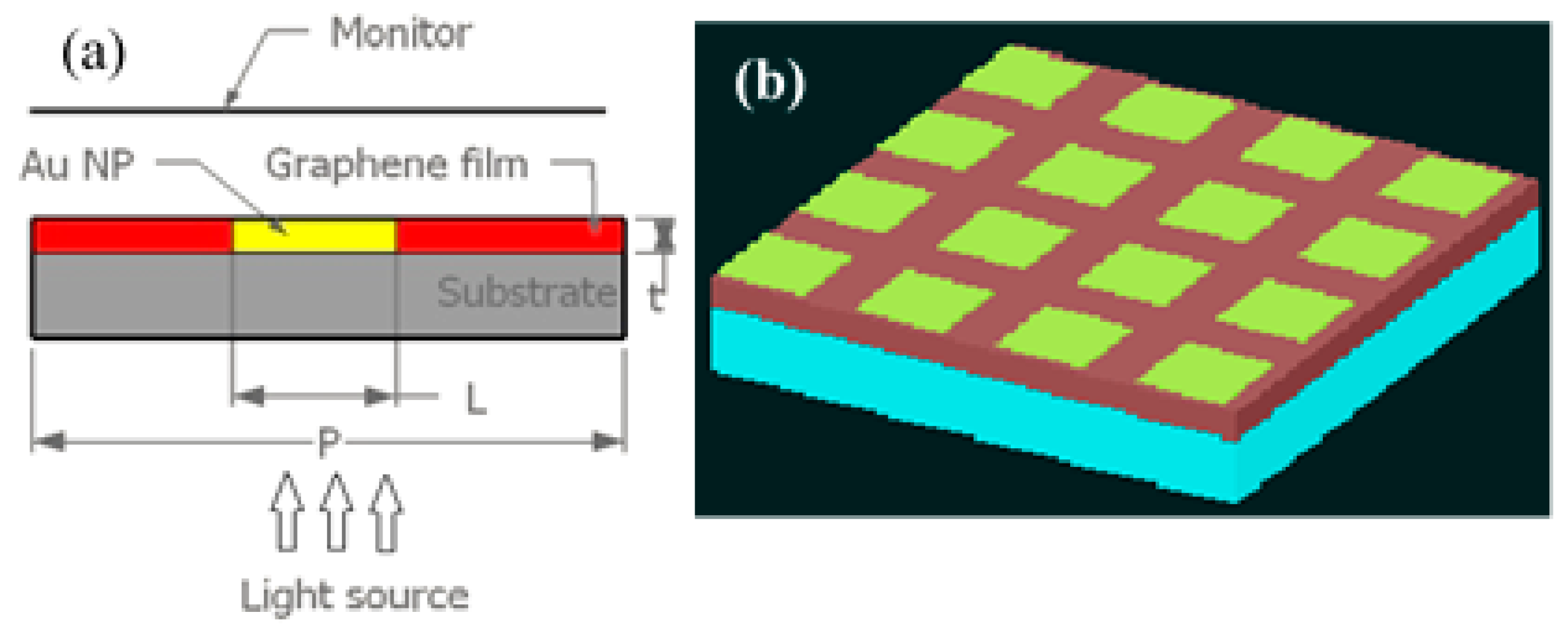
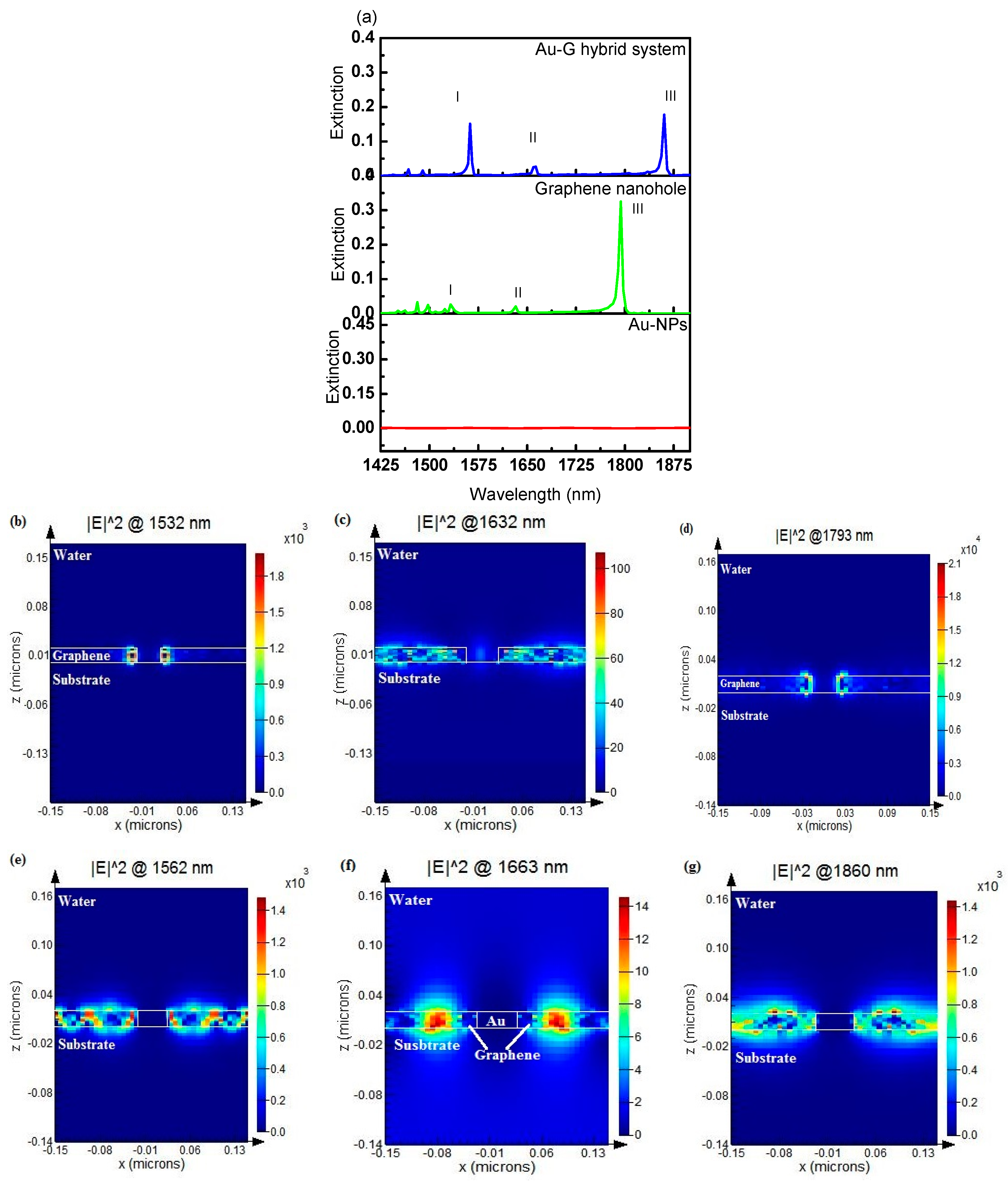

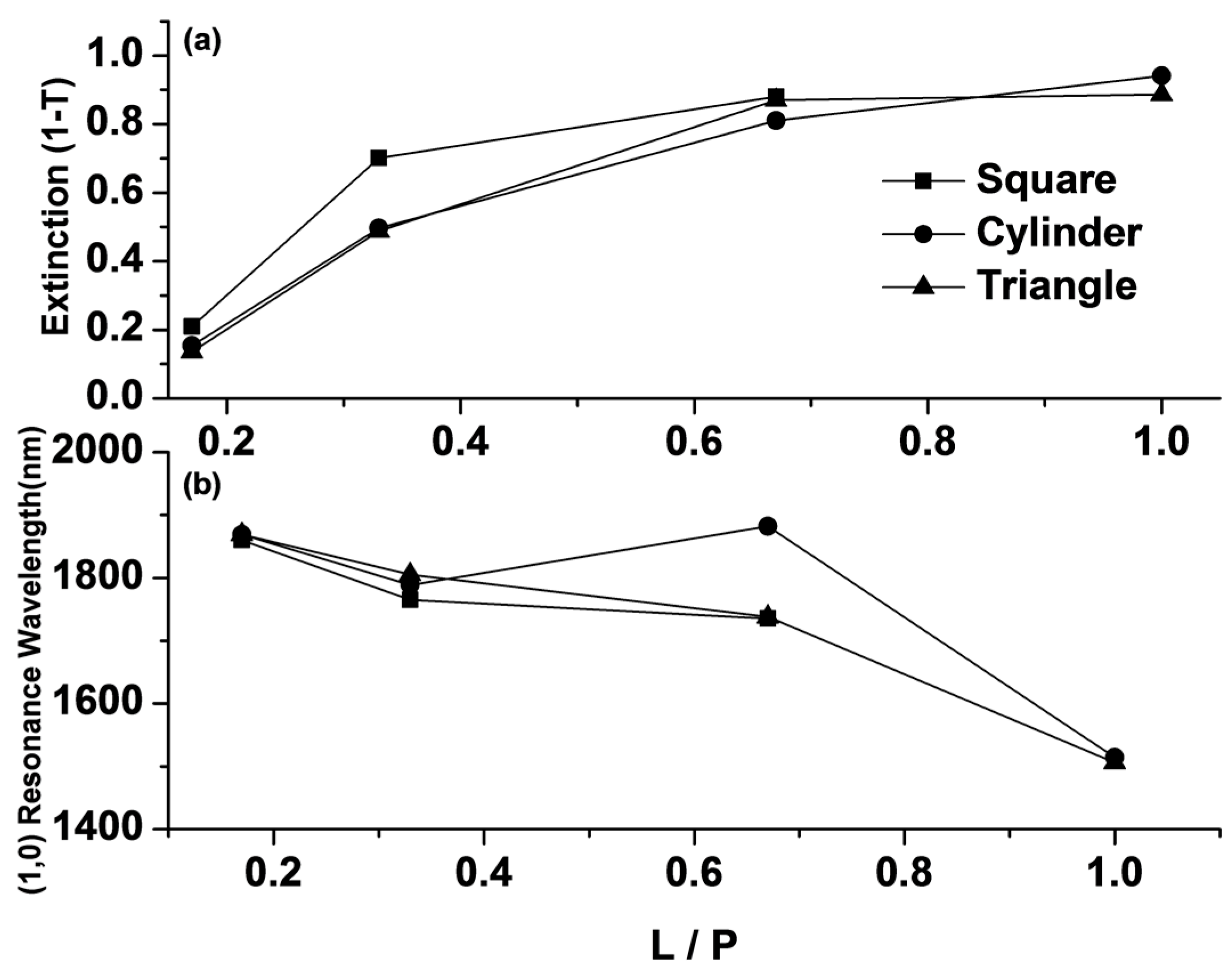
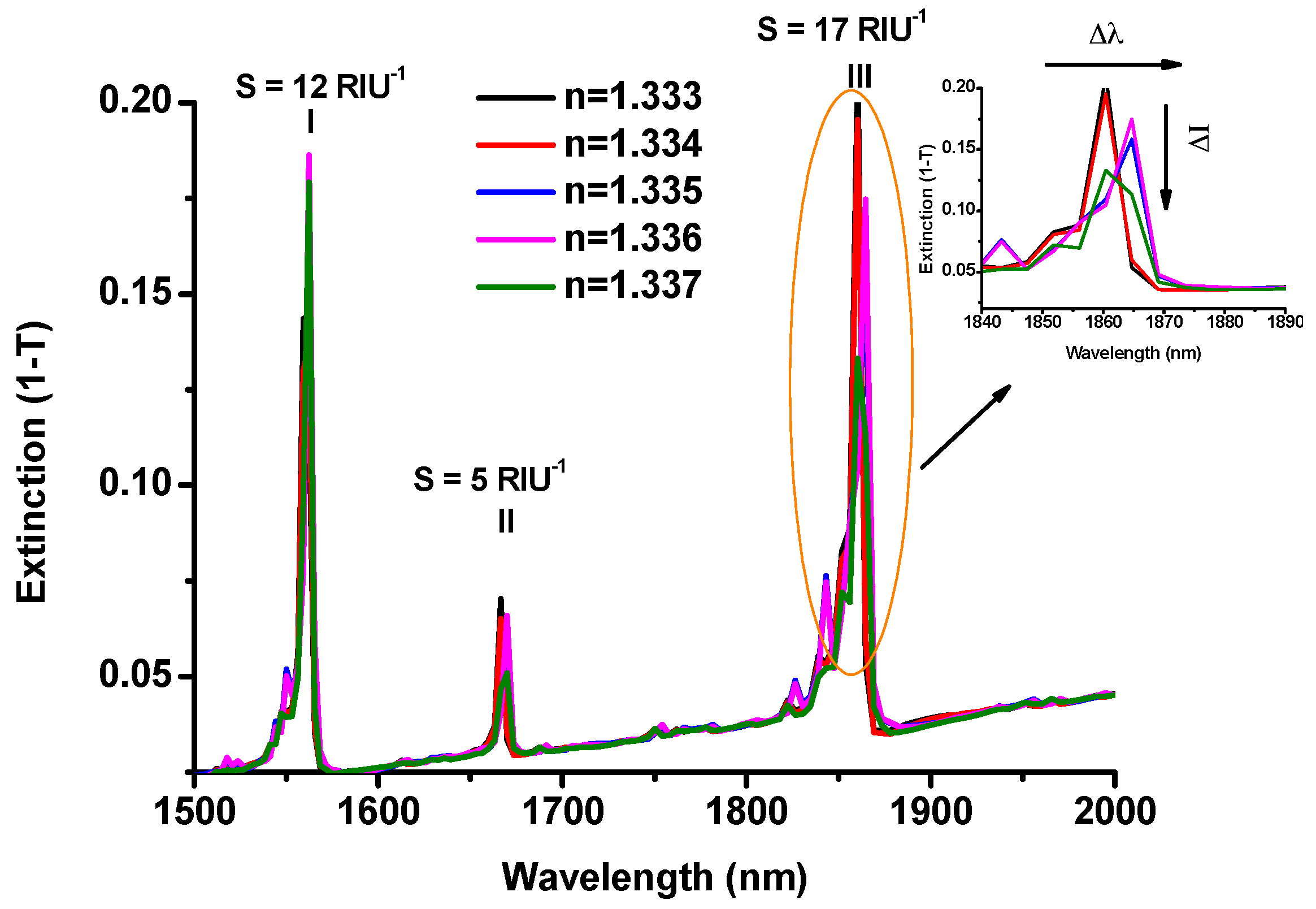
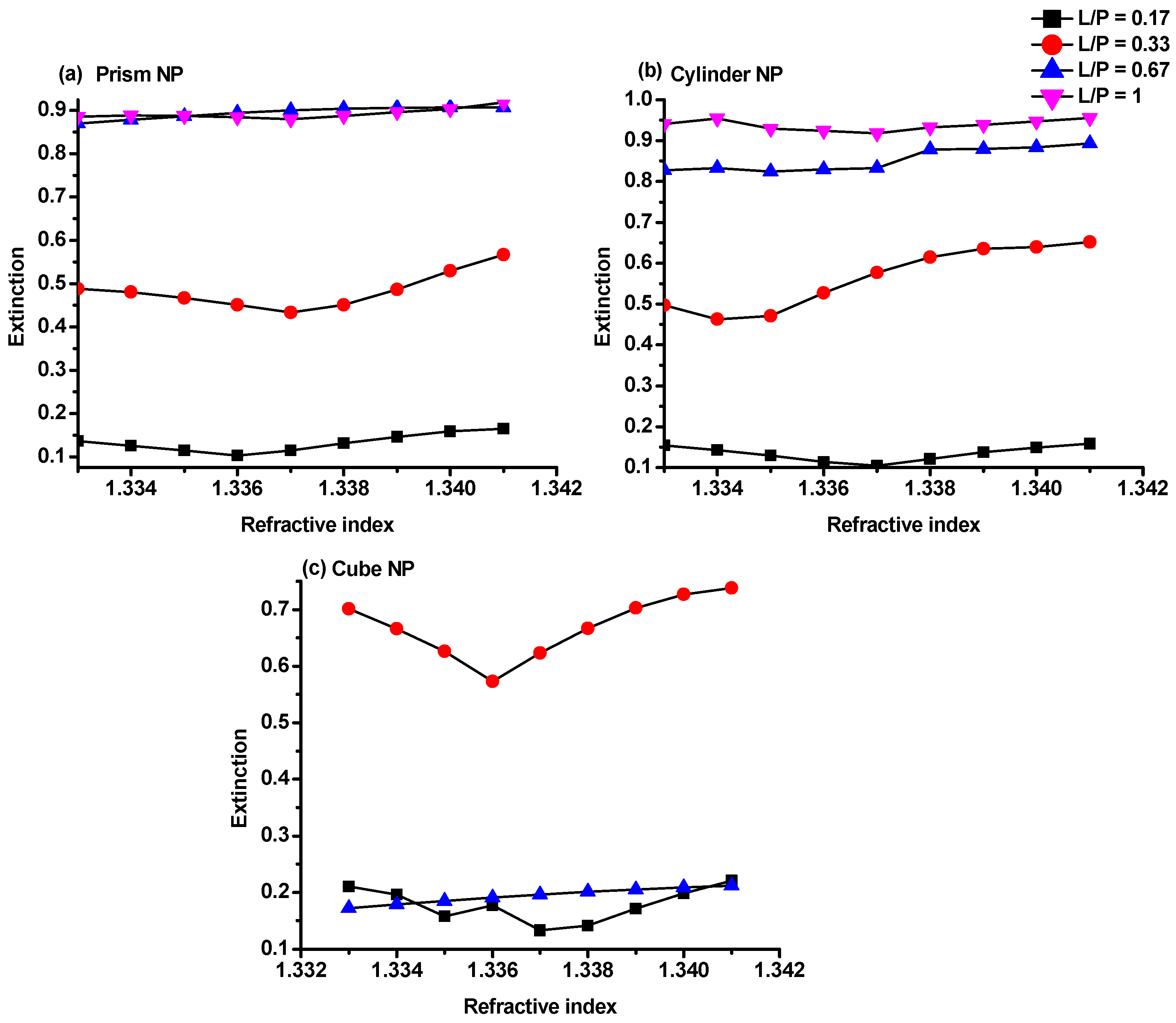

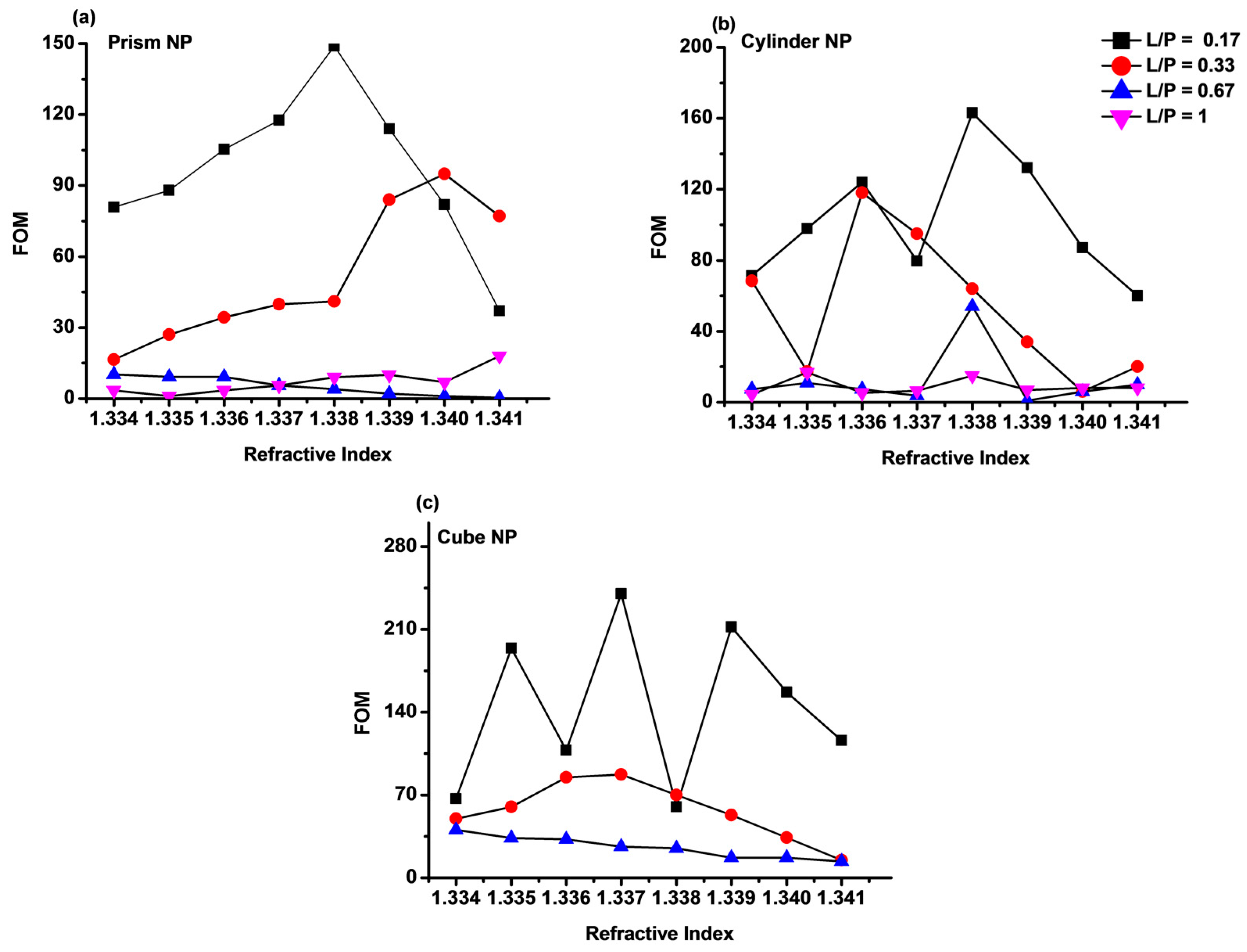
| NP | λresoance (nm) | Shift (nm) | n1 | n2 | Sλ (nm/RIU) | FOM |
|---|---|---|---|---|---|---|
| Prism | 1805 | 4.38 | 1.336 | 1.337 | 4380 | 273 |
| Cylindrical | 1789 | 4.02 | 1.334 | 1.335 | 4020 | 390 |
| Cubic | 1765 | 4.34 | 1.334 | 1.335 | 4340 | 307 |
© 2017 by the authors; licensee MDPI, Basel, Switzerland. This article is an open access article distributed under the terms and conditions of the Creative Commons Attribution (CC BY) license (http://creativecommons.org/licenses/by/4.0/).
Share and Cite
Alharbi, R.; Irannejad, M.; Yavuz, M. Au-Graphene Hybrid Plasmonic Nanostructure Sensor Based on Intensity Shift. Sensors 2017, 17, 191. https://doi.org/10.3390/s17010191
Alharbi R, Irannejad M, Yavuz M. Au-Graphene Hybrid Plasmonic Nanostructure Sensor Based on Intensity Shift. Sensors. 2017; 17(1):191. https://doi.org/10.3390/s17010191
Chicago/Turabian StyleAlharbi, Raed, Mehrdad Irannejad, and Mustafa Yavuz. 2017. "Au-Graphene Hybrid Plasmonic Nanostructure Sensor Based on Intensity Shift" Sensors 17, no. 1: 191. https://doi.org/10.3390/s17010191






